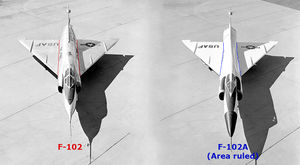Whitcomb area rule
Explanation
When an aircraft approaches the transonic flow regime, the local airflow around some parts and wings tend to accelerate to supersonic speeds, forming shock waves. This formation of shockwaves causes a rapid increase in the drag in the form of wave drag. Whitcomb’s area rule is an aerodynamic design configuration suggested by Dr. Richard Whitcomb as a solution to reduce this transonic wave drag when the F-102 aircraft failed to reach the supersonic speed due to transonic wave drag. The area rule proposed to indent the fuselage at the waist so that the change in the cross-sectional area of the total body is as smooth and continuous as possible.
Frequently Asked Questions
How does the area rule work?
The Sears-Haack body is the theoretical design that could provide an efficient supersonic flight with the lowest theoretical wave drag possible. It is because of the fact that the area distribution is smooth. But in normal aircraft like the F-102, the area distribution is not smooth due to the presence of the wings and other parts. By indenting and reducing the volume of the fuselage around the waist, the cross-sectional area remains close to a smoother distribution without any rapid discontinuities. This significantly reduces the wave drag.

